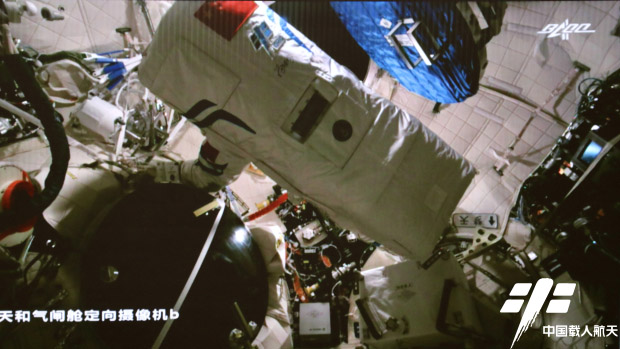Chinese astronauts complete second spacewalk at new space station

Two Chinese astronauts conducted their second spacewalk outside of the country's new space station on Friday (Aug. 20), installing a range of equipment including a backup air-conditioning unit.
Astronauts Liu Boming and Nie Haisheng exited the station's core module at 10:12 a.m. Beijing time (10:13 p.m. EDT on Thursday evening), according to the China Manned Space Agency. Their colleague, Tang Hongbo, the third member of the Shenzhou 12 mission, remained inside to support the two.
During the four-hour sortie, Liu and Nie installed a range of devices outside of the station. First, they attached a foot restraint and a platform for their extravehicular activity (EVA) on the space station's robotic arm, which then helped them transport other equipment around the station.
Related: Russia, China reveal moon base roadmap but no plans for astronaut trips yet
The spacewalkers installed a thermal control pumping set, an important part of the space station's air-conditioning system, which will serve as a backup for the circulating pump inside the module. They also attached a bracket to the panoramic camera near the hatch, which will help improve the camera's view of the space station.
The astronauts returned to the module at 2:33 p.m. Beijing time (2:33 a.m. EDT), one hour ahead of schedule, according to the state-controlled news outlet China Central Television (CCTV).
"I would like to thank all participants for their strong cooperation and the people all over the country for their care and love," Liu Boming said in the CCTV webcast upon his return.
Get the Space.com Newsletter
Breaking space news, the latest updates on rocket launches, skywatching events and more!
Liu was also a part of the team that performed the first EVA outside of the new space station on July 4, about two weeks after the crew's arrival at the station. At that time, he was accompanied by Tang, while Nie stayed inside. The three astronauts are expected to remain in space for three months, which will make their mission China's longest to date.


China launched the space station's core module, called Tianhe ("Harmony of the Heavens" in English) on April 28. At 54.4 feet (16.6 meters) long, 13.8 feet (4.2 m) across at its widest point, and with a mass of 22.5 tons, Tianhe is the largest spacecraft China has ever built. An additional two modules, Wentian and Mengtian, will join the core module next year to form a planned T-shaped space station that will be able to sustain long-term human presence.
The Shenzhou 12 crew will return to Earth in mid-September. The space station is part of China's ambitious drive to increase its presence in space. The east-Asian superpower has also announced plans to establish an exploration base on the moon together with Russia and has successfully landed a rover on Mars earlier this year.
Follow Tereza Pultarova on Twitter @TerezaPultarova. Follow us on Twitter @Spacedotcom and on Facebook.
Join our Space Forums to keep talking space on the latest missions, night sky and more! And if you have a news tip, correction or comment, let us know at: community@space.com.

Tereza is a London-based science and technology journalist, aspiring fiction writer and amateur gymnast. Originally from Prague, the Czech Republic, she spent the first seven years of her career working as a reporter, script-writer and presenter for various TV programmes of the Czech Public Service Television. She later took a career break to pursue further education and added a Master's in Science from the International Space University, France, to her Bachelor's in Journalism and Master's in Cultural Anthropology from Prague's Charles University. She worked as a reporter at the Engineering and Technology magazine, freelanced for a range of publications including Live Science, Space.com, Professional Engineering, Via Satellite and Space News and served as a maternity cover science editor at the European Space Agency.









